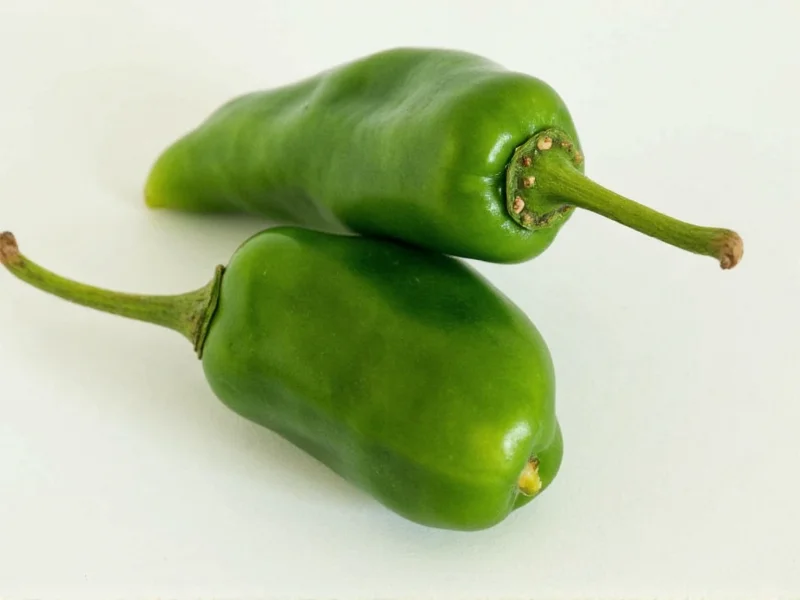Understanding poblano pepper appearance helps home cooks and gardeners identify this versatile chili correctly. These mild-to-medium heat peppers play starring roles in dishes like chiles rellenos and mole sauces, making visual identification essential for authentic preparation.
Physical Characteristics of Fresh Poblano Peppers
When selecting poblano peppers at your local market, look for these distinctive features:
- Size: Typically 4-6 inches in length and 2-3 inches in width at their broadest point
- Shape: Heart-shaped or teardrop silhouette with a rounded bottom tapering to a point
- Color: Deep, glossy green when immature; transitions to rich red as it fully ripens
- Surface: Smooth, thick skin with subtle wrinkles appearing near the stem
- Stem: Medium-length, sturdy stem that's often slightly curved
- Interior: Thick flesh surrounding a central seed cavity with white ribs
Color Development Through Maturation
Poblano peppers undergo significant visual transformation as they mature. Understanding these stages helps determine flavor profile and culinary applications:
| Maturation Stage | Color | Size | Texture | Common Name |
|---|---|---|---|---|
| Immature | Dark green | 4-6" long, 2-3" wide | Glossy, firm skin | Poblano |
| Mature | Bright to deep red | Slightly larger than green stage | Softer skin, more wrinkles | Red Poblano |
| Dried | Deep mahogany brown | Shrinks to 3-4" long | Wrinkled, leathery texture | Ancho |
How Poblanos Compare to Similar Peppers
Many shoppers confuse poblanos with other common peppers. Recognizing these visual differences prevents recipe mishaps:
Poblano vs Bell Pepper: While both have similar heart shapes, poblanos are smaller (bell peppers reach 6-8" long), have thinner walls, and feature a more tapered point. Bell peppers maintain consistent color throughout maturation, while poblanos change from green to red.
Poblano vs Jalapeño: Jalapeños are significantly smaller (2-3" long), cylindrical rather than heart-shaped, and develop characteristic white striations as they mature. Poblanos have smoother skin and lack the jalapeño's pronounced taper.
Poblano vs Anaheim: Anaheims grow longer (6-10") with a more slender, curved shape resembling a banana. They maintain a brighter green color and have thinner walls than the stockier, darker green poblano.
Practical Identification Tips for Shoppers
When searching for poblanos in grocery stores, follow these visual identification guidelines:
- Look for peppers with the distinctive heart shape rather than the blocky form of bell peppers
- Choose specimens with deep, uniform green color and minimal blemishes
- Feel for substantial weight indicating thick, meaty walls ideal for stuffing
- Avoid peppers with soft spots, wrinkles (except near stem), or color variations
- Remember that red poblanos are simply mature versions, not a different variety
Many supermarkets mislabel peppers, so don't rely solely on signage. The most reliable identification comes from recognizing the characteristic shape and proportions. When in doubt, compare potential poblanos to nearby bell peppers—true poblanos should appear noticeably smaller and more tapered.
Why Appearance Matters for Cooking
The visual characteristics of poblano peppers directly impact their culinary performance. The thick walls (typically 1/4-3/8 inch) make them perfect for stuffing, while their size accommodates generous fillings without falling apart during cooking. The smooth skin blisters beautifully under broilers or open flames, facilitating easy removal for dishes like rajas con crema.
Color indicates ripeness and flavor development. Green poblanos offer fresh, grassy notes with mild heat (1,000-2,000 Scoville units), while red specimens develop sweeter, fruitier flavors with slightly more heat. Dried anchos provide the deep, raisin-like complexity essential to traditional mole sauces.
Common Misidentifications to Avoid
Several visual mistakes commonly occur when identifying poblanos:
- Mistaking large green bell peppers for poblanos (check shape and wall thickness)
- Confusing mature red poblanos with pasilla peppers (poblanos are heart-shaped; pasillas are longer and narrower)
- Assuming all heart-shaped peppers are poblanos (check size—true poblanos rarely exceed 6" long)
- Overlooking that dried poblanos become anchos (different name, same pepper)
When shopping internationally or at farmers markets, remember that regional names vary. In Mexico, you might hear "chile ancho" for the dried form or "chile poblano" for the fresh pepper, while some U.S. markets incorrectly label them as "pasilla" peppers.











 浙公网安备
33010002000092号
浙公网安备
33010002000092号 浙B2-20120091-4
浙B2-20120091-4